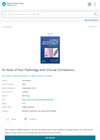Diagnostic Usefulness of a Peribulbar Eosinophilic Infiltrate in Alopecia Areata
September 2014
in “
JAMA Dermatology
”

TLDR Eosinophilic infiltrate is not a reliable indicator for diagnosing chronic alopecia areata.
The study conducted at Chungbuk National University Hospital analyzed 162 scalp biopsy specimens from patients with alopecia areata (AA) and found that eosinophilic infiltrate around hair bulbs was present in only 18.5% of cases, with a lower occurrence of 7.1% during the chronic stage. The presence of eosinophils was less frequent in chronic AA without a definite peribulbar lymphocytic infiltrate, suggesting limited diagnostic value for eosinophilic infiltrate in AA. Instead, other histopathologic features such as pigmentary incontinence, follicular miniaturization, and a shift to the catagen or telogen phase were more indicative for diagnosis in chronic AA. Despite the small control group, this study is considered the largest to investigate the frequency of eosinophilic infiltrate in AA.




